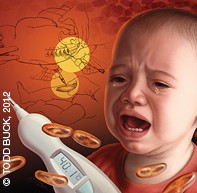Peer Reviewed
Feature Article Paediatrics
Recurrent infection in childhood: how much is too much?
Abstract
Even the healthiest children can suffer frequent infections, leading to considerable parental concern. This article discusses the normal frequencies of infection in different contexts, and the features that should raise suspicion of immunodeficiency.
Key Points
- Young infants can be expected to have at least six infections per year, with an average of 10 infections for those in institutional childcare.
- Recurrent infection of a single site or organ is commonly due to an anatomical abnormality at that site.
- Features that should raise the question of immunodeficiency include undue severity of infection, recurrent deep-seated infections, lack of response to antibiotics, failure to thrive and the involvement of less virulent causative organisms.
- When there is no causative organism, consider a noninfective reason for recurrent symptoms, such as a periodic fever syndrome.

